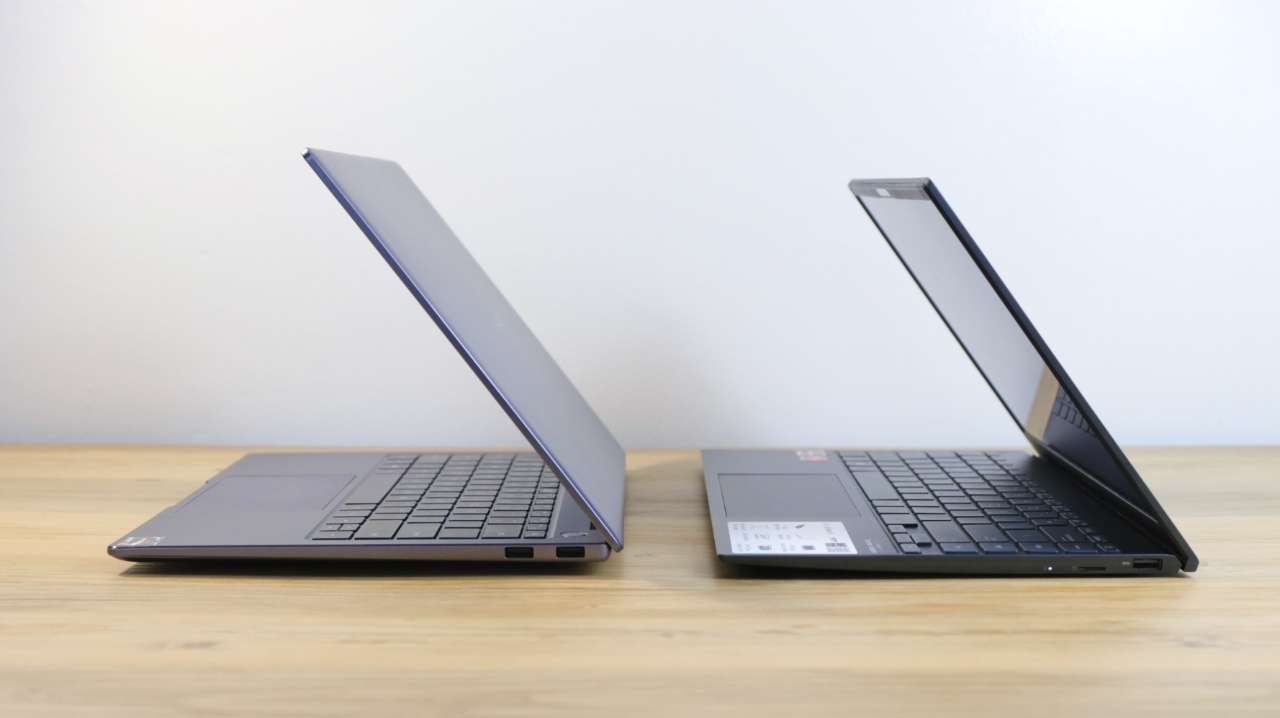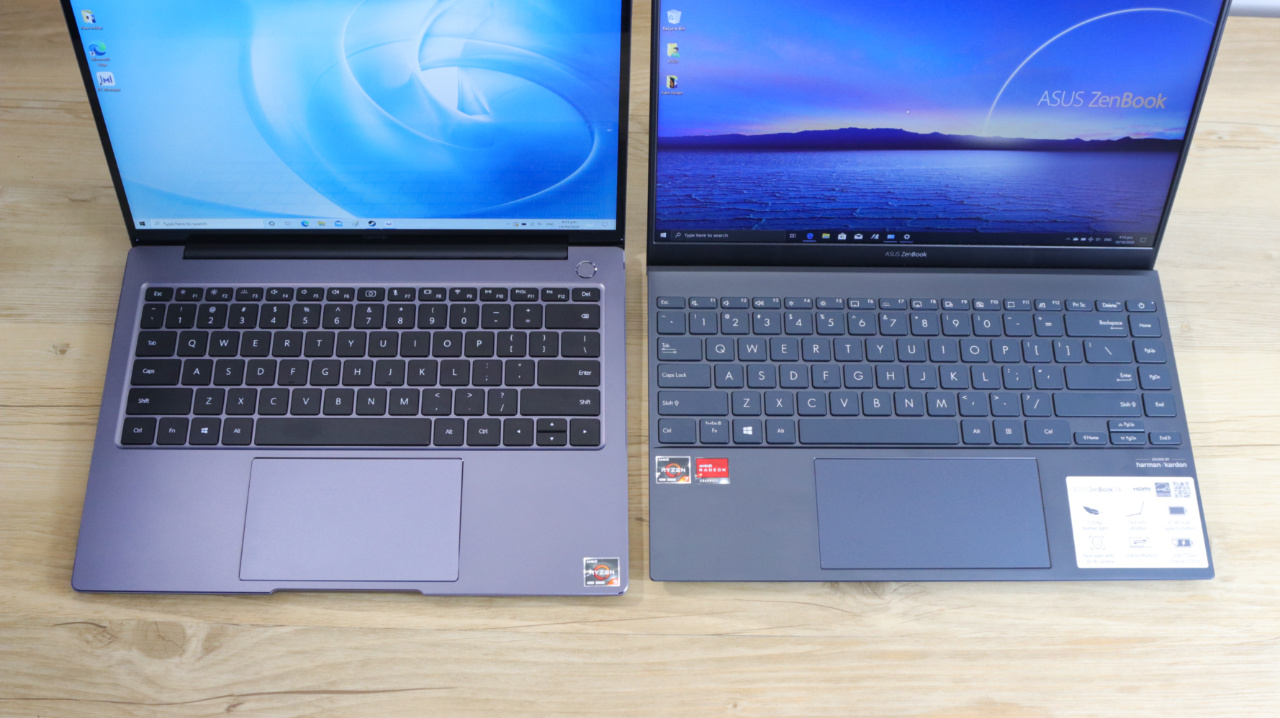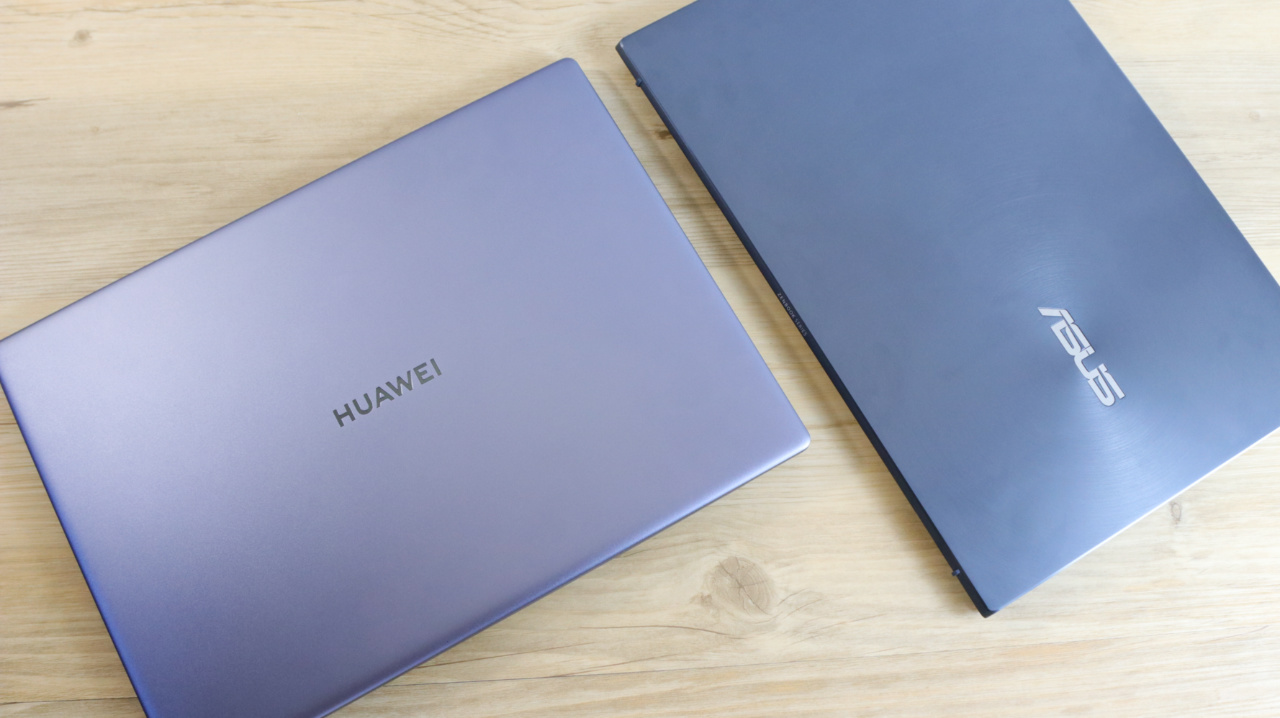Notebooks are in-demand these days as more people continue to work or study from home. Times are difficult, so everyone is looking for the right device to satisfy their needs and provide the best value for the money. For that matter, we can look at two laptops powered by the new AMD Ryzen 4000 Mobile processor, the Huawei MateBook 14, and the ASUS ZenBook 14. Let’s find out which one is the best to get.

Table of Contents
Right off the bat, we can say that both laptops are premium and well-made thanks to their metal bodies that feel solid and cool to touch.

They have different looks, though. The MateBook 14 has a sandblasted finish in Space Gray, while the ZenBook 14 has a spun-metal finish in Pine Grey. The former has this curvier edges while the latter has sharper edges.

Both have stable and sturdy hinges. The MateBook 14, however, feels stiff. The ZenBook 14, on the other hand, features the smoother ErgoLift hinge that lifts the rear of the laptop slightly for better airflow and ergonomics.

Inside, the MateBook 14 has a backlit full-size chiclet keyboard, while the ZenBook 14 features an Edge-to-Edge keyboard, which takes the whole width of the laptop to make some room for extra keys. Both also have smooth and large trackpads. The MateBook 14 just has a taller trackpad, while the ZenBook 14 is wider. In terms of backlighting, we find the ZenBook 14’s to be brighter.

The MateBook 14 features a fingerprint scanner built-in the power button when it comes to biometrics, while the ZenBook 14 uses a 3D infrared camera with Windows Hello for face logins.

For the webcam, both have HD cameras but of different placement. The ZenBook 14 has it on the top bezel like most laptops. For the MateBook 14, it has a pop-up camera hidden between the F6 and F7 keys. While the latter provides physical control over your privacy, we’re no fan of the camera’s lower angle, unlike the one on the ZenBook 14.

As for the size, the ZenBook 14 is more compact and lighter at 1.43cm height, 31.9cm width, 21cm depth, and 1.22kg weight. The MateBook 14, on the other hand, has 1.59cm height, 30.75cm width, 22.38cm depth, 1.49kg weight.
While both laptops have great and attractive builds, we’re casting our vote on the ASUS ZenBook 14.
The MateBook 14 has two USB 3.2 Type-A ports, one USB-C port, a 3.5mm headphone/mic jack, and an HDMI port when it comes to ports.

The ZenBook 14, on the other hand, has two USB 3.2 Type-C ports, one USB 3.2 Type-A, an HDMI port, and a microSD card reader. ASUS also included a dongle for the 3.5mm jack and ethernet.
As for wireless connectivity, the MateBook 14 has WiFi 802.11 ac, Bluetooth 5.0, and Huawei Share tag built in the trackpad. For the ZenBook 14, it has the newer WiFi 802.11 ax and Bluetooth 5.0.
For this aspect, we’re putting our vote on the ASUS ZenBook 14.
Now let’s take a look at their displays and speakers. The MateBook 14, as the name suggests, boasts a 14-inch IPS screen with 2160 x 1440 resolution or 185ppi at a 3:2 aspect ratio. The taller screen allows you to view more content. It also has 300 nits of brightness and 100% sRGB color gamut.

The ZenBook 14, on the other hand, has a 14-inch IPS screen with 1920 x 1080 resolution or 157ppi, 16:9 aspect ratio, and 250 nits of brightness.
Both have loudspeakers placed at the bottom, good enough for video calls, and or for watching videos.
In this part, we’re putting our vote on the Huawei MateBook 14.
AMD Ryzen 4000 Mobile processors power the two devices. However, the CPUs are of different tiers. The MateBook 14 has the AMD Ryzen 5 4600H with AMD Radeon Graphics, while the ZenBook 14 has the AMD Ryzen 7 4700U with AMD Radeon Graphics. The former has the 4000 H-Series designed for high-performance laptops, while the U-Series is for ultrabooks. Both have their own merits.

To see if there are any differences in performance, let’s take a look at their benchmarks scores:
| Huawei MateBook 14 | ASUS ZenBook 14 | |
|---|---|---|
| PC Mark 10 Extended | 4,097 | 4,199 |
| 3DMark | 966 (Time Spy) | 1,047 (Time Spy) |
| 2,562 (Fire Strike) | 2,978 (Fire Strike) | |
| Geekbench 5 | 1,112 (Single-Core) | 1,129 (Single-Core) |
| 5,707 (Multi-Core) | 5,523 (Multi-Core) | |
| 10,509 (OpenCL) | 12,192 (OpenCL) | |
| Cinebench R20 | 3,092 (CPU) | 2,659 (CPU) |
| 453 (CPU – Single-Core) | 472 (CPU – Single-Core) |
Based on the scores, we can see that both laptops lead in some benchmark categories. However, that difference is too small for a regular user to notice. Both are responsive and can handle basic tasks well.
However, the Matebook 14’s Ryzen 5 4600H has twelve threads, compared to the ZenBook 14’s eight. The former also has a TDP of 40W in contrast to the latter’s 15W TDP. This gives the Matebook 14 a sizable advantage in multithreaded workloads such as image processing, video editing, 3D animation, and more.
In this case, we’re giving a point to the MateBook 14.
When it comes to RAM capacity, the MateBook 14 has 16GB DDR4, while the ZenBook 14 has 8GB DDR4. In this case, the former wins. The larger the RAM capacity, the better the laptop can handle multitasking.
Storage-wise, both devices have 512GB SSDs; however, their performance is different. The MateBook 14 uses a Samsung SSD, which is faster than the Kingston SSD used in the ZenBook 14. For this aspect, the MateBook 14 wins.
| Huawei MateBook 14 | ASUS ZenBook 14 | |
|---|---|---|
| CrystalDiskMark | 3,571.22 MB/s (Seq. Read) | 1,989.17 MB/s (Seq. Read) |
| 2,988.08 MB/s (Seq. Write) | 982.22 MB/s (Seq. Write) |
Both laptops are powered by Windows 10 Home with Office 365 trials, Microsoft’s YourPhone, AMD Radeon Software, and McAfee software trial. They differ, though, in exclusive features. The ZenBook 14 features the MyASUS software to check on the laptop’s health and make diagnoses. The MateBook 14, on the other hand, has the PC Manager which is more comprehensive as it can do system checks, fix issues, and update drivers.

There’s also Huawei Share, allowing you to transfer files from your Huawei smartphone to the laptop by simply tapping it on the trackpad. There’s also Multi-screen collaboration to increase your productivity by making a seamless connection between the laptop and the Huawei device. There’s also the Nahimic software to tweak audio settings and profiles.
We can see that the MateBook 14 has extra features that can be fully utilized by existing Huawei smartphone users.
The ZenBook 14 is equipped with a 67Wh battery, while the MateBook 14 has a smaller 56Wh battery. The former wins in terms of capacity.
To test the battery further, we did our usual video loop test on both devices by playing a 1080p video on loop at 50% brightness and volume, in Airplane mode and Better Battery mode. The MateBook 14 got 10 hours of playback, while the ZenBook 14 got 14 hours and 12 minutes.
The ZenBook 14 wins this round.
Lastly, we have the price. The MateBook 14 is priced at PHP 54,999USD 937INR 79,452EUR 893CNY 6,825, while the ZenBook 14 is at PHP 49,995USD 852INR 72,223EUR 811CNY 6,204. While it’s easy to choose the ZenBook 14 for the price, for an extra PHP 5,004USD 85INR 7,229EUR 81CNY 621, you can get a laptop with a better display, larger RAM, faster SSD, and extra software features. Given the difference in hardware and use cases, we’re still giving points for both devices.

Let’s do a recap.
Design – ZenBook 14
Connectivity – ZenBook 14
Display and speakers – MateBook 14
Processor – MateBook 14
RAM – MateBook 14
Storage – MateBook 14
OS and features – MateBook 14
Battery – ZenBook 14
Price – ZenBook 14, MateBook 14
The MateBook 14 got points on 6 categories out of 9, while the ZenBook 14 got points in 4 out of 9. While the ZenBook 14 has a lower price, we have to consider the value you’re getting if you shell out more. If you have a smaller budget, prefer a smaller laptop with longer battery life, get the ZenBook 14. But if you have the extra budget, I think you can get more value with the MateBook 14. The higher screen resolution, larger RAM, faster storage, powerful processor, and extra features will provide you with better work and play advantage.

YugaTech.com is the largest and longest-running technology site in the Philippines. Originally established in October 2002, the site was transformed into a full-fledged technology platform in 2005.
How to transfer, withdraw money from PayPal to GCash
Prices of Starlink satellite in the Philippines
Install Google GBox to Huawei smartphones
Pag-IBIG MP2 online application
How to check PhilHealth contributions online
How to find your SIM card serial number
Globe, PLDT, Converge, Sky: Unli fiber internet plans compared
10 biggest games in the Google Play Store
LTO periodic medical exam for 10-year licenses
Netflix codes to unlock hidden TV shows, movies
Apple, Asus, Cherry Mobile, Huawei, LG, Nokia, Oppo, Samsung, Sony, Vivo, Xiaomi, Lenovo, Infinix Mobile, Pocophone, Honor, iPhone, OnePlus, Tecno, Realme, HTC, Gionee, Kata, IQ00, Redmi, Razer, CloudFone, Motorola, Panasonic, TCL, Wiko
Best Android smartphones between PHP 20,000 - 25,000
Smartphones under PHP 10,000 in the Philippines
Smartphones under PHP 12K Philippines
Best smartphones for kids under PHP 7,000
Smartphones under PHP 15,000 in the Philippines
Best Android smartphones between PHP 15,000 - 20,000
Smartphones under PHP 20,000 in the Philippines
Most affordable 5G phones in the Philippines under PHP 20K
5G smartphones in the Philippines under PHP 16K
Smartphone pricelist Philippines 2024
Smartphone pricelist Philippines 2023
Smartphone pricelist Philippines 2022
Smartphone pricelist Philippines 2021
Smartphone pricelist Philippines 2020
Ayeh says:
Unfortunately, both laptops are already phased out or already out of stock without the intention of restocking.